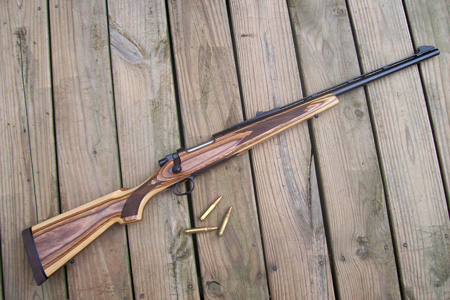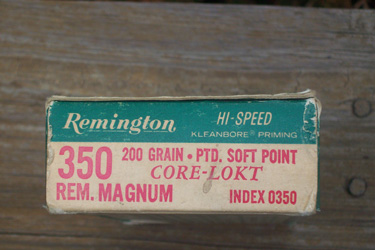

Some time ago in these pages I made a few predictions about which of today’s currently produced guns stood a decent chance of becoming collectibles. One of the guns that appeared in my crystal ball was Remington’s Model 673 Guide Rifle.
At the time, I hazarded the guess that the Model 673 wouldn’t remain in production very long.
And guess what? I was right! (According to my wife, this was the first documented instance in which I have ever been right about anything.) The Model 673 bit the dust in 2006. I suppose I’m sad to see it fade so swiftly from Remington’s lineup, though I’m not surprised. Like the gun whose styling it mimicked, the Remington Model 600 Magnum Carbine of 1965, it was just too funky to last.
For those of you who came in late, the Remington Model 673 Guide Rifle was, to paraphrase Yosemite Sam, “the meanest, toughest, rip-snortin’-est, Edward-Everett-Horton-est” variation of the compact Model Seven that Remington ever produced. Introduced in 2003, it was an aggressively retro-styled bolt-action rifle chambered in a number of fire-breathing short magnum cartridges. The Model 673 debuted in .350 Remington Magnum and .300 Short Action Ultra Mag (SAUM) in 2003. In 2004 it was chambered for the 6.5 Remington Magnum and .308 Winchester chamberings.
Now I’ve fired a couple of Model Sevens in .308 Winchester and .260 Remington, and the recoil was noticeable but not severe for a 6-1/2-lb. rifle. But stick a .350 Remington Magnum or .300 SAUM cartridge in a Model 673 and it’s a different picture entirely.

True, the Model 673 has a few touches that increase its weight compared to that of the original Model 600 Magnum Carbine — such as a full-length steel vent rib and a laminated stock — but it still barely tips the scales at 7-1/4 lbs. Not a heavy gun, certainly, but one that some might consider on the skinny side for a couple of hellbent-for-leather cartridges that approximate the ballistics of the .35 Whelen and .300 Winchester Magnum, respectively.
I suppose it’s a good thing that I wasn’t in a position to shoot the original Remington Model 600 Magnum Carbine back in 1965. In fact, I don’t think I would handle it very well even today. The original Model 600 Magnum Carbine had an 18-inch barrel and weighed only 6.2 pounds, compared to the Model 673’s 22-inch barrel and 7.25 pounds.
Shooting an original Model 600 Carbine must have been like stuffing an M-80 in a piece of cast-iron gas pipe, lighting it, and holding it up to your head. So the Model 673 is probably pretty tame compared to the original flame-throwing Model 600 Magnum Carbine.
Or maybe I’m just a wimp. Writing about the new Model 600 .350 carbine in the 1967 edition of Gun Digest, author Bob Hagel didn’t even mention its recoil or blast. He praised the gun to the skies, saying “There is little doubt that this cartridge and carbine will be popular, especially among hunters who hunt in the brush. It is adequate for the heaviest American game and should make an ideal rifle-cartridge combination for life insurance on the salmon streams of Alaska’s brown bear country.”
Alas, it was not to be. The Model 600 Magnum Carbine hit the canvas after only three years — which, in an ironic twist of fate, is exactly how long the Model 673 Guide Rifle lasted.
When I first heard of the Model 673’s demise, I went out and bought one chambered in .350. Why? First reason: I might not live to see it, but I’m still confident that the rifle will become a collectible, especially in the old .350 and 6.5mm chamberings. Second reason: I had approximately 130 original .350 Magnum factory loads sitting around with nothing to shoot them in. Third reason: I’m fascinated with the “guide gun” mini-boom that peaked in the past few years.
That last reason is important to me. I’ve spent 20 years in corporate marketing and advertising, and I view modern firearms marketing trends in a spirit of professional interest. It may be a new camo pattern, a new champagne bottle-shaped ultra magnum, a new titanium alloy, a new retro revival, whatever. I’m endlessly interested in these latest-and-greatest fads that sweep the industry every other year and then fade away into nothingness. The Guide Rifle fad was one of them.
I suppose it all started with Marlin’s Model 1895GS Guide Gun back around 1998. This was a stainless 18-inch-barreled lever action chambered for the .45-70. The 1895GS had a ported barrel, which was fine for shooting the old fuddy-duddy 405-grain .45-70 load. When you slipped something like a Garrett Cartridges .45-70 Hammerhead into the 1895GS, however, things started to get loopy. I remember sighting in my ported 1895GS and wondering after a few shots whether I would accidentally set my sandbags on fire.
That experience got me thinking: how many professional guides are there in the world, anyway? How big of a market can there be for a “Guide Gun”? Not much, probably. Naturally, most Guide Guns are sold to non-guides — in other words, to people who don’t really need them. There’s nothing wrong with that. After all, there’s a big difference between “need” and “want.” But it’s precisely these flash-in-the-pan mini-booms that create collectible firearms. (Remember those two casualties of the mini-boom in long-range handgunning 40-some years ago, the .256 Ruger Hawkeye and Smith & Wesson’s Model 53 in .22 Remington Jet? Both are hot collectibles today.)
So here I sit, as far from being a professional guide as anyone could possibly get, with a new Model 673 Guide Rifle in .350 Remington Magnum resting in my gun rack. Because I believe that all guns, collectible or not, are made to be fired, I recently loaded up some .357, 160-gr. hollowpoint loads to see how much of a mess I could make out of five-gallon contractor’s paint cans filled with water. The answer: plenty.
There’s something thrilling about seeing a paint can lid rise 20 feet into the air, borne aloft by a mushroom cloud of water vapor. Accuracy with the 160-grain loads was only so-so, about 2.5 inches at 75 yards, probably because the short bullet was overstabilized by the gun’s rifling. With my factory 200-grain stuff, old as it is, the 673 will almost cut cloverleafs at 75 yards if I hold my mouth just right. That may not seem impressive to you, but if anything dangerous ever pops up in front of me more than 75 yards away, I’m not going to shoot at it. I’m going to run away from it, probably screaming.
I’m aware that there are now more custom bullets available for the .350 than there were 40 years ago, and I wouldn’t mind noodling around with something on the order of a 225-grain softpoint if I were hunting elk or really big woodchucks. But the .350’s stubby case doesn’t cotton to long bullets, and the old 250-grain factory load is probably the most the case can take and still feed reliably.
The Model 673 differs from the original Model 600 Magnum Carbine in a few noticeable ways. It doesn’t have that funky dogleg bolt handle; the vent rib on the barrel is steel, not nylon (the better to act as a heat sink during extended shooting sessions, I suppose); and perhaps most importantly, its stock has very little drop. It’s a rifle that’s made for a high scope mount unless a) you’re built like the Hunchback of Notre Dame and your head is situated between your shoulder blades, or b) your scope has a pretty small bell. Scope with large bells may bump heads with the rear sight mounted on the barrel rib.
I’ve just done a quick price check on Model 673 Guide Rifles. At the moment, they can be had new in the box in the mid-$500 range in your choice of 6.5mm, .308, .300 SAUM, or .350. It might take me awhile, but sooner or later I suppose I’ll just have to have one of each.
And why not? Like I said, there’s a big difference between “need” and “want.”
This article appeared in the November 23, 2009 issue of Gun Digest the Magazine.

Next Step: Get your FREE Printable Target Pack
Enhance your shooting precision with our 62 MOA Targets, perfect for rifles and handguns. Crafted in collaboration with Storm Tactical for accuracy and versatility.
Subscribe to the Gun Digest email newsletter and get your downloadable target pack sent straight to your inbox. Stay updated with the latest firearms info in the industry.

![Best Concealed Carry Guns In 2025 [Field Tested] Wilson Combat EDC X9S 1](https://gundigest.com/wp-content/uploads/Wilson-Combat-EDC-X9S-1-324x160.jpg)


![Best 9mm Carbine: Affordable PCCs [Tested] Ruger Carbine Shooting](https://gundigest.com/wp-content/uploads/Ruger-Carbine-Shooting-100x70.jpg)
![Best AR-15: Top Options Available Today [Field Tested] Harrington and Richardson PSA XM177E2 feature](https://gundigest.com/wp-content/uploads/Harrington-and-Richardson-PSA-XM177E2-feature-100x70.jpg)

My father left my Brother and I two of these rifles when he passed away. Like you, he imagined they would become collectibles one day. Here in 2025, I’m not sure if that’s true or not. My Brother introduced us to the 350 Magnum with his short actioned Remington Model 700 Classic. He convinced my father, a staunch Model 740 in .308 man, of its effectiveness on deer and bear in our temperate jungly Northern Vermont environment. My father soon found himself a 700 Classic in .350. (I have that rifle, as well.) I myself, was a convert to large caliber, standard cartridges, when out of a fit of nostalgia from reading old African Hunter books, I purchased my first 9.3x62mm. After watching how that performed, my Brother picked up the .350. The first thing I noticed about the Remington 673 in .350 was the three hole accuracy you speak of. We don’t think of large caliber rifles as tack drivers. I can assure you that a 9.3mm is a capable woodchuck gun, should you ever be faced with an aggressive varmint. The .350 Remington in the 673 will print clover leaves all day long despite the slender barrel profile. While not the lightest rifle I own, it is relatively handy. The laminated stock is as beautiful as the barrel rib is eye catching. The sites are even adequate for a factory rifle. I’m looking forward to finding a deer with this rifle. Thanks for your article.
I feel like you were writing my story. The Remington 673 in 350 mag. Is a great firearm. I am a little disappointed that the caliber didn’t catch on, as ammunition is hard to obtain. I have an ample supply for the near future but I hope someone does a run on the 350, so I can continue to enjoy hunting with my favorite rifle. Thanks for sharing your story.
I stumbled upon this article for no other reason than by chance seeking out information on “older” Remington rifles. Your writing style had me chuckling at 2:30AM. I know these are unprecedented times in the firearms industry, let alone life in general. Let your wife know that there are entirely two 673’s on gunbroker. One currently with a high bid of $1600. It’s good to be correct once in awhile :).